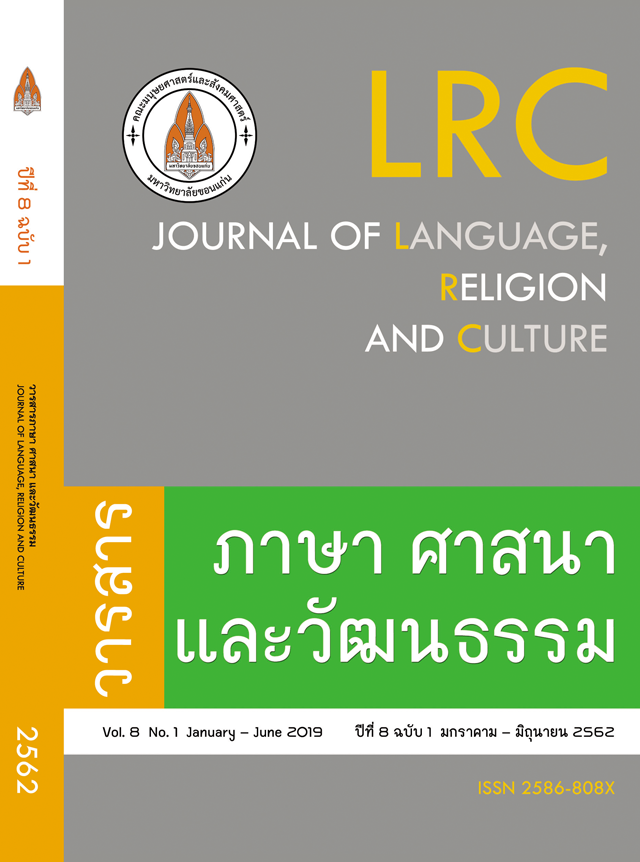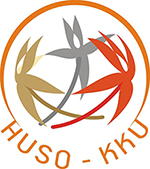ความสุขในชีวิตของผู้สูงอายุ ภาคตะวันออกเฉียงเหนือ; Life Happiness of Elderly in Northeast
Keywords:
ความสุข, ผู้สูงอายุ, การเข้าถึงทุน, การเห็นคุณค่าในตนเอง, Happiness, Elderly, Access to Capital, Self-esteemAbstract
บทความนี้มุ่งศึกษาความสุขในชีวิตของผู้สูงอายุ และปัจจัยที่มีความสัมพันธ์กับความสุขในชีวิตของผู้สูงอายุ ภาคตะวันออกเฉียงเหนือ ใช้ระเบียบวิธีวิจัยแบบผสม มีหน่วยวิเคราะห์ข้อมูลในระดับปัจเจก เก็บรวบรวมข้อมูลเชิงคุณภาพในเดือนธันวาคม 2559 ด้วยวิธีการสัมภาษณ์เชิงลึก และเชิงปริมาณในเดือนมิถุนายน 2560 ด้วยแบบสัมภาษณ์ กับผู้สูงอายุเขตเมืองและเขตชนบทในจังหวัดขอนแก่น และชัยภูมิ ซึ่งพื้นที่ที่มีสัดส่วนของผู้สูงอายุสูงที่สุดในภาคตะวันออกเฉียงเหนือ การวิเคราะห์ข้อมูล ใช้การวิเคราะห์เชิงเนื้อหา สถิติพรรณนา และค่าสัมประสิทธิ์สหสัมพันธ์ เพื่อทดสอบปัจจัยที่มีความสัมพันธ์กับความสุขในชีวิตของผู้สูงอายุ ภาคตะวันออกเฉียงเหนือ ผลการศึกษาพบว่า ผู้สูงอายุส่วนใหญ่มีอายุเฉลี่ย 71.6 ปี อาศัยอยู่กับลูกและหลาน ร้อยละ 30.8 มีรายได้ไม่เกิน 3,000 บาทต่อเดือน ราวครึ่งหนึ่งไม่มีเงินออม ผู้สูงอายุส่วนใหญ่มีความสุขในชีวิตโดยรวม ประกอบด้วย มิติสุขภาพดี ความมั่นคงทางเศรษฐกิจ ครอบครัวอบอุ่น และการช่วยเหลือสังคม ผลการวิเคราะห์เชิงปริมาณ พบว่า ผู้สูงอายุมีความสุขในชีวิตในระดับสูงร้อยละ 52.8 โดยมิติครอบครัวอบอุ่น มีระดับสูงที่สุด และมิติความมั่นคงทางเศรษฐกิจต่ำที่สุด ทั้งนี้พบว่า อายุ จำนวนเงินออม การได้รับการยอมรับจากครอบครัวและชุมชน การเห็นคุณค่าในตนเอง ความสัมพันธ์กับคนในครอบครัว และการเข้าถึงทุน มีความสัมพันธ์กับความสุขในชีวิตของผู้สูงอายุ
Abstract
This article aims to examine life happiness of elderly people and factors associated to life happiness of elderly people in the northeast of Thailand. Research methodology was sequential mixed methodology with individual level as a unit of analysis. Data were collected in December 2016 by in-depth interview and interview schedule respectively with elderly people in Khon Kaen and Chaiyaphum provinces, where presented the highest proportion of elderly people in northeastern region. Data were analyzed by content analysis, descriptive statistics and correlation analysis to examine factors associated with the life happiness of elderly people in the northeast of Thailand. The results showed that the elderly people had mean age 71.6 years old, and 30.8 percent stayed with their sons/daughters and nephews. 50.8 percent of elderly people sample had an income lower than USD90.45 which was less than the poverty line (USD110.56) but more than half of elderly people sample were on savings. The elderly people have a high level of overall life happiness which composed of health, economic, family and social support dimensions at 52.8 percent. While the elderly people got the life happiness at the highest level in family dimension, they got the lowest level of the economic dimension. The factors associated to the life happiness of elderly people were age, amount of saving, family and community recognition, self-esteem, family relationships, and access to capital.
References
ธนาคารแห่งประเทศไทย. (2561). รายงานฐานะทางการเงินประจำปี 2561. กรุงเทพฯ: ธนาคารแห่งประเทศไทย.
นภาพร อติวานิชยพงศ์. (2557). คนชนบทอีสานกับการทำมาหากิน: ความเปลี่ยนแปลงตามยุคสมัย. วารสารสังคมวิทยาและมานุษยวิทยา, 33(2), 103-127.
ปรีชา อุปโยคิน. (2556). ความสุขของผู้สูงอายุ. วารสารกองการแพทย์ทางเลือก. 6(1), 31-36.
ปิยวัฒน์ เกตุวงศา. (2560). ลักษณะการอยู่อาศัยและความอยู่ดีมีสุขของครัวเรือนชนบทไทย. วารสารประชากร, 5(1), 107-130.
วิทมา ธรรมเจริญ. (2559). อิทธิพลของปัจจัยภายนอกและปัจจัยภายในที่มีต่อความสุขของผู้สูงอายุ. วิทยานิพนธ์ปริญญาโท หลักสูตรวิทยาศาสตร์มหาบัณฑิต (สถิติประยุกต์) สถาบันบัณฑิตพัฒนบริหารศาสตร์.
สมชาย ศักดาเวคีอิสร. (2544). การพัฒนาเครื่องชี้วัดความอยูดีมีสุข. (ออนไลน์). สืบค้นเมื่อ 15 ตุลาคม 2560, จาก www.jvkk.go.th/research/qrresearch.asp?code=201440007341.
สำนักงานกองทุนสนับสนุนการสร้างเสริมสุขภาพ. (2550). คู่มือความสุข 8 ประการ. กรุงเทพฯ: สำนักงานกองทุนสนับสนุนการสร้างเสรมสุขภาพ.
สำนักงานคณะกรรมการพัฒนาการเศรษฐกิจและสังคมแห่งชาติ. (2561). การคาดประมาณประชากรปี 2583. กรุงเทพฯ : สำนักกงานคณะกรรมการพัฒนาการเศรษฐกิจและสังคมแห่งชาติ.
สำนักงานสถิติแห่งชาติ. (2560). รายงานผลเบื้องต้นสำรวจประชากรสูงอายุในประเทศไทย พ.ศ.2560. (ออนไลน์). สืบค้นเมื่อ 20 ตุลาคม 2561, จาก
https://www.m-society.go.th/article_attach/14494/18145.pdf.
สุจิตรา สมพงษ์. (2559). ความสุขของผู้สูงอายุในบ้านพักคนชรา จังหวัดนครปฐม. วิทยานิพนธ์ปริญญาโท หลักสูตรศิลปศาสตรมหาบัณฑิต (จิตวิทยาชุมชน) มหาวิทยาลัยศิลปากร.
Bishop, A., Martin, P., MacDonald, M., & Arnold, J. (2010). Predicting Happiness among Centenarians, Gerontology, 56(1), 88-92.
Bourdieu, P. & Wacquant, L. (1992). An Invitation to Reflexive Sociology. Cambridge: Polity Press.
Chimjinda, J. (2013). The Factors Influencing Life Happiness Amongst the Elderly at a Community in Nakhon Pathom Province. Thesis of Community Nurse Practitoner; M.N.S. (Community Nurse Practitioner), Christian University of Thailand.
Department for International Development. (1999). Sustainable livelihoods guidance sheets. Glasgow: Department for International Development.
Ergin, I. & Mandiracioglu, A. (2015). Demographic and socioeconomic inequalities for self-rated health and happiness in elderly: The situation for Turkey regarding World Values Survey between 1990 and 2013. Archives of Gerontology and Geriatrics, 61(2), 224-230.
Frankenberger, T.R., Drinkwater, M. & Maxwell, D. (2000). Operationalizing Household Livelihood Security - A holistic approach for addressing poverty and vulnerability. Program Document, CARE USA. Atlanta,GA: CARE.
Frey, B.S., & Stutzer, A., (2002). What Can Economists Learn from Happiness Research?. Journal of Economic Literature, 40(2), 402-435.
Gray, R.S., Rukumnuaykit, P., Kittisuksathit, S. & Thongthai, V. (2008). Inner happiness among Thai elderly. Journal of Cross Cultural Gerontology. (23): 211-224.
Hau Chyi and Shangyi Mao. (2011). The Determinants of Happiness of China’s Elderly Population. (Online). Journal of Happiness Studies. From : https://link.springer.com/article/10.1007/s10902-011-9256-8.
Kae Hwa Jo and Byung Sook Song (2012). Effect of family cohesion, subjective happiness and other factors on death anxiety in Korean elders. Journal of Korean Academy of Nursing 42: 680–688.
Kramanon, R. & Gray, R. (2015). Differentials in Happiness among the Young Old, the Middle Old and the Very Old in Thailand, 23(2), 180-193.
Luchesi et al. (2018). Factors associated with happiness in the elderly persons living in the community. Archives of Gerontology and Geriatrics, 74(2), 83-87.
Miret et al. (2014). Health and happiness: cross-sectional household surveys in Finland, Poland and Spain. Bull World Health Organ, 2014(92), 716-725.
Moeini B, Barati M, Farhadian M, Babamiri M, Heydari Ara M. et al. (2018). Happiness and Its Related Factors among the Elderly in Hamadan (Iran): A Cross Sectional Study. Avicenna J Neuro Psycho Physiology, 3(4), 260-265.
Narongchai, W., Ayuwat, D., and Chinnasri, O. (2016). The Changing of Intergenerational Transfers of Economic Capital in Rural Households in Northeastern, Thailand. Kasetsart Journal (Social Sciences), 37(2), 46-52.
Putnam, R. (2002). Democracies in Flux : The Evolution of Social Capital in Contemporary Society. Oxford : Oxford University Press.
Rattanaprathum, N., Ayuwat, D., and Sriruecha, C. (2015). “The Vulnerability Perception of Urban Elder in KhonKaen, Thailand.” International Business Management, 9 (3). 208-214.
Teddlie, C. & Tashakkori, A. (2009). Foundations of Mixed Methods Research Integrating Quantitative and Qualitative Approaches in the Social and Behavioral Sciences. LA: SAGE Publishing.
Thongsuk, Y., (2016). Factors influencing psychological well–being among older adults. Major: Mental Health and Psychiatric Nursing; M.N.S (Mental Health and Psychiatric Nursing), Burapha University.
Xiang et al (2017). Relationship between psychological capital and life quality in elderly people. Western Pacific Region Index Medicus, 31(9), 718-722.
Wong, W.P., Lau, H.B., Kwok, C.N., Leung, Y.A., & Chan, M.G., Chan, W., & Chueng, S.K. (2014). The well – being of community – dwelling near – centenarians and centenarians in Hong Kong: A qualitative study. BMC Geriatrics, 14:63.







